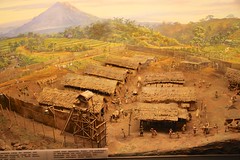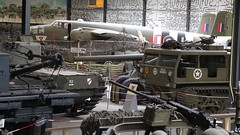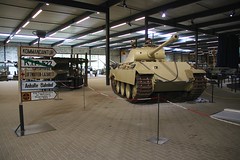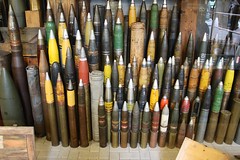The Overloon Oorlogsmuseum in Liberty Park near Eindhoven and Nijmegen with its collection of military vehicles is the largest war museum in The Netherlands.
The Overloon Oorlogsmuseum is the largest war museum in The Netherlands. The museum is in Liberty Park where the largest tank battle in Dutch history took place during the Second World War just miles from the German border. The complex includes the National War and Resistance Museum as well as the Marshall Museum with its vast collection of more than 200 historic military vehicles.
2025 — online tickets with time-slot reservations are not essential to visit the Overloon War Museum but are cheaper and sensible to ensure admission on busy days.
The Overloon Oorlogsmuseum in Liberty Park
The Oorlogsmuseum Overloon is an enormous war museum in a large park in the small town Overloon in North Brabant in the far east of The Netherlands. It is a huge museum with comprehensive coverage of the Second World War in The Netherlands. The collection of over 200 military vehicles makes it one of the largest in Europe.
The museum is in Liberty Park, a large woodland park that saw action at the start of the Second World War when Germany invaded The Netherlands and again more spectacularly in 1944. The Battle of Overloon (September 30 to October 18, 1944) was the largest tank battle ever on Dutch soil and due to its ferocity is also referred to as the Second Battle of Caen.
Original bunkers and military hardware in the park remind of these events. On the trail leading to the museum building are several artworks commemorating various events, people, and groups affected by the Second World War.
The war museum building itself can be divided into two main areas:
- Nationaal Oorlogs- en Verzetsmuseum (National War and Resistance Museum) – the traditional museum covering various aspects related to the Second World War.
- Marshall Museum – a huge hall with around 200 military vehicles and other war equipment mostly from the Jaap de Groot collection.
The military vehicles are probably the most interesting part of the museum for most visitors making it sensible to see this enormous hall last. However, the museums are in one building making it easy to backtrack or cross over at any time.
The Dutch National War and Resistance Museum in Overloon
The Nationaal Oorlogs- en Verzetsmuseum focuses on The Netherlands in the Second World War but also covers several themes of larger European interest. Almost all signs and descriptions are in Dutch, English, and German.
The museum explains the run-up to the Second World War from 1918 onwards. The Netherlands remained neutral during the First World War and was hoping for the same second time round. The German army overrun the Netherlands within days in May 1940 thus much coverage is given to the following occupation. (Visit the Verzetsmuseum (Resistance Museum) in Amsterdam for extensive coverage.) A small section also explains the fight against and occupation by the Japanese the Dutch India — the modern-day Indonesia.
Other more pan-European themes include resistance (all European countries saw resistance against the Nazis in some form although the French resistance is the most famous), the influence of propaganda, the Holocaust, and the role of paratroopers.
In the Block Buster, visitors can experience an air raid. First visitors spend a few minutes inside a plane dropping bombs over a city, then hear the noise and see the flashes inside a town center, and finally spend a few minutes in an air raid shelter during the bombardment.
Multimedia
The multimedia exhibition follows the current flavor of the month for Dutch war museums by posing the question: “Wat zou u doen?” (“What would you do?”). It encourages visitors to evaluate the information and try to imagine what they would have done in the same circumstances but an honest answer is unfortunately highly unlikely given the influences of hindsight. However, it does confirm the importance when studying history of considering what people knew and were thinking at a specific time to understand why things happened, or were allowed to happen, in a particular way.
The museum has more information than anyone can take in on a single day. However, even visitors more interested in military vehicles should consider a quick walkthrough and a maybe closer look at a few items that catch the eye.
Marshall Museum in Overloon
The around 200 military vehicles crammed into a huge warehouse as the Marshall Museum are the main attractions of the Overloon War Museum. Military vehicles of all kinds are on display here with hardware from all nations. The majority of the vehicles, planes, and boats are from the Second World War but a few items are older while many are from the Cold War period.
Some of the material is set up as if in a battlefield but generally, the vehicles are packed tight in broad themes to get in as many as possible. Special dioramas include the D-Day invasion of Normandy, the battles of Arnhem and the Ardennes, and Cold War-era equipment used by the Warsaw Pact countries.
Notable Military Vehicles in the Overloon Museum
A few notable vehicles on display include amongst others:
- A Renault TF-17 tank – the only tank owned by the Dutch in 1940.
- A German Panther tank damaged during the Battle of Overloon.
- A Soviet T-34 tank in full working condition.
- A B-25 Mitchell bomber and a Spitfire.
- A German Biber mini-U-.
Other items displayed include various weapon systems, German radio equipment, mobile searchlights, mines, and over a thousand bombs and grenades. A large collection of support vehicles confirms the importance of logistics for success in war.
The museum does not really explain the role of the various vehicles in war and some are not described at all. Technical details, where provided, are in Dutch, German, and English. Audioguides are also available.
Many of the vehicles on display are in immaculate condition, as the museum generally takes the equipment apart to the last bolt during restoration projects. Demonstrations are held a few times per year.
→ To see German tanks, from the First World War to the present, visit the German Tank Museum near Munster and Soltau to the south of Hamburg.
Visitor Information for the Overloon War Museum
The Oorlogsmuseum Overloon is open year-round on weekdays from 10 am to 5 pm and on weekends and public holidays from 11 am to 5 pm. The museum is closed on December 24, 25, 31, and January 1.
Advance purchase online tickets with timeslot reservations give skip-the-line admission on busy days but is not currently essential. The Dutch Museum Pass (Museumkaart) is valid and time slot reservations are not necessary.
Admission tickets are €19.50 for adults and €14.50 for children 4 to 12.
Although admission is fairly pricy, the museum is also vast. A walk-through and cursory glance at a few exhibitions will easily take two hours. It is best to plan on spending at least half a day or more at the museum.
The museum has a large café with further coffee shops and fast-food restaurants available outside Liberty Park.
Transportation to the Overloon War Museum
Getting to the Overloon Oorlogsmuseum is easiest by car. A large, free parking lot is available.
Overloon is in the far east of The Netherlands only a couple of kilometers from the border with Germany. Overloon is a small village between the towns Venray and Boxmeer – use exit 7 from the A73 highway. Larger Dutch cities in the vicinity include Eindhoven, Nijmegen, Arnhem, Venlo, and Maastricht while German cities such as Duisburg and Düsseldorf are within easy driving distance.
Arriving by bicycle is also very popular. A cycling bridge runs through the museum giving cyclists a free view during the regular opening times.
Overloon is also a popular bus excursion destination for passengers on Rhine River boat cruises, especially when calling at Nijmegen.
On weekdays, it is possible to reach the museum by bus. Use stop Overloon, Museumlaan, which is a ten-minute walk away. Note the huge gaps in the schedule before traveling. No buses are available on weekends.
Weeze Airport (NRN) in Germany is less than 10 km away but the lack of direct roads (and the border and the River Maas) means driving takes at least half an hour. Public transportation is not an option.









